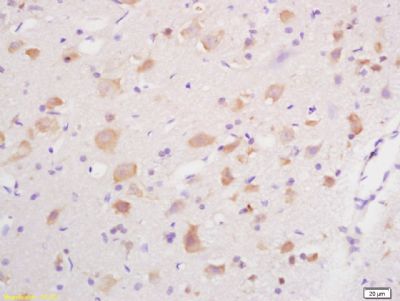产品货号 : mlR4112
英文名称 : GABA A Receptor gamma 2
中文名称 : γ氨基丁酸γ2受体/GABAA Rγ2抗体
别 名 : GABRG2; CAE 2; CAE2; ECA 2; ECA2; GABA(A) receptor subunit gamma 2; GABA(A) receptor subunit gamma-2; GABRG 2; GABRG2 antibody Gamma aminobutyric acid (GABA) A receptor gamma 2; Gamma aminobutyric acid A receptor gamma 2; Gamma aminobutyric acid receptor gamma 2 subunit; Gamma-aminobutyric acid receptor subunit gamma-2; Gamma-aminobutyric-acid receptor gamma-2 subunit; GBRG2_HUMAN; GEFSP 3; GEFSP3.
研究领域 : 免疫学 神经生物学 细胞膜受体
抗体来源 : Rabbit
克隆类型 : Polyclonal
交叉反应 : Human, Mouse, Rat, Dog, Pig, Cow, Horse,
产品应用 : WB=1:500-2000 ELISA=1:500-1000 IHC-P=1:400-800 IHC-F=1:400-800 ICC=1:100-500 IF=1:200-800 (石蜡切片需做抗原修复)
not yet tested in other applications.
optimal dilutions/concentrations should be determined by the end user.
分 子 量 : 51kDa
细胞定位 : 细胞膜
性 状 : Lyophilized or Liquid
浓 度 : 1mg/ml
免 疫 原 : KLH conjugated synthetic peptide derived from human GABRG2/GABA A Receptor gamma 2:41-140/475 <Extracellular>
亚 型 : IgG
纯化方法 : affinity purified by Protein A
储 存 液 : 0.01M TBS(pH7.4) with 1% BSA, 0.03% Proclin300 and 50% Glycerol.
保存条件 : Store at -20 °C for one year. Avoid repeated freeze/thaw cycles. The lyophilized antibody is stable at room temperature for at least one month and for greater than a year when kept at -20°C. When reconstituted in sterile pH 7.4 0.01M PBS or diluent of antibody the antibody is stable for at least two weeks at 2-4 °C.
PubMed : PubMed
产品介绍background:
GABA, the major inhibitory neurotransmitter in the vertebrate brain, mediates neuronal inhibition by binding to the GABA/benzodiazepine receptor and opening an integral chloride channel.
Function:
GABA, the major inhibitory neurotransmitter in the vertebrate brain, mediates neuronal inhibition by binding to the GABA/benzodiazepine receptor and opening an integral chloride channel.
Subunit:
Generally pentameric. There are five types of GABA(A) receptor chains: alpha, beta, gamma, delta, and rho.
Subcellular Location:
Cell membrane.; Cell junction, synapse, postsynaptic cell membrane; Multi-pass membrane protein. Cell membrane; Multi-pass membrane protein.
Post-translational modifications:
Palmitoylated by ZDHHC3/GODZ; which may affect presynaptic clustering and/or cell surface stability.
DISEASE:
Defects in GABRG2 are the cause of childhood absence epilepsy type 2 (ECA2) [MIM:607681]. ECA2 is a subtype of idiopathic generalized epilepsy (IGE) characterized by an onset at age 6-7 years, frequent absence seizures (several per day) and bilateral, synchronous, symmetric 3-Hz spike waves on EEG. During adolescence, tonic-clonic and myoclonic seizures develop. Some individuals manifest ECA2 occurring in combination with febrile convulsions.
Defects in GABRG2 are the cause of familial febrile convulsions type 8 (FEB8) [MIM:611277]. A febrile convulsion is defined as a seizure event in infancy or childhood, usually occurring between 6 months and 6 years of age, associated with fever but without any evidence of intracranial infection or defined pathologic or traumatic cause. Febrile convulsions affect 5-12% of infants and children up to 6 years of age. There is epidemiological evidence that febrile seizures are associated with subsequent afebrile and unprovoked seizures in 2% to 7% of patients.
Defects in GABRG2 are the cause of generalized epilepsy with febrile seizures plus type 3 (GEFS+3) [MIM:604233]. Generalized epilepsy with febrile seizures-plus refers to a rare autosomal dominant, familial condition with incomplete penetrance and large intrafamilial variability. Patients display febrile seizures persisting sometimes beyond the age of 6 years and/or a variety of afebrile seizure types. GEFS+ is a disease combining febrile seizures, generalized seizures often precipitated by fever at age 6 years or more, and partial seizures, with a variable degree of severity.
Defects in GABRG2 are a cause of severe myoclonic epilepsy in infancy (SMEI) [MIM:607208]; also called Dravet syndrome. SMEI is a rare disorder characterized by generalized tonic, clonic, and tonic-clonic seizures that are initially induced by fever and begin during the first year of life. Later, patients also manifest other seizure types, including absence, myoclonic, and simple and complex partial seizures. Psychomotor development delay is observed around the second year of life. SMEI is considered to be the most severe phenotype within the spectrum of generalized epilepsies with febrile seizures-plus.
Similarity:
Belongs to the ligand-gated ion channel (TC 1.A.9) family. Gamma-aminobutyric acid receptor (TC 1.A.9.5) subfamily. GABRG2 sub-subfamily.
SWISS:
P18507
Gene ID:
2566
Important Note:
This product as supplied is intended for research use only, not for use in human, therapeutic or diagnostic applications.
产品图片












